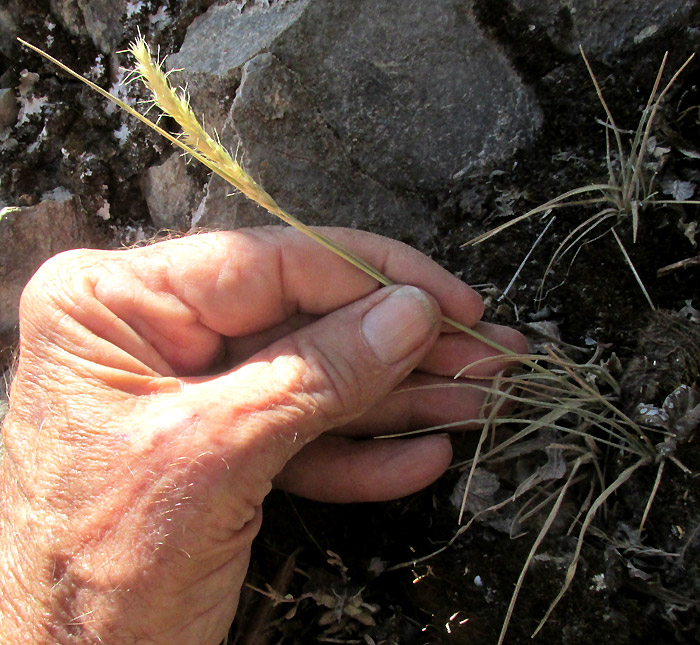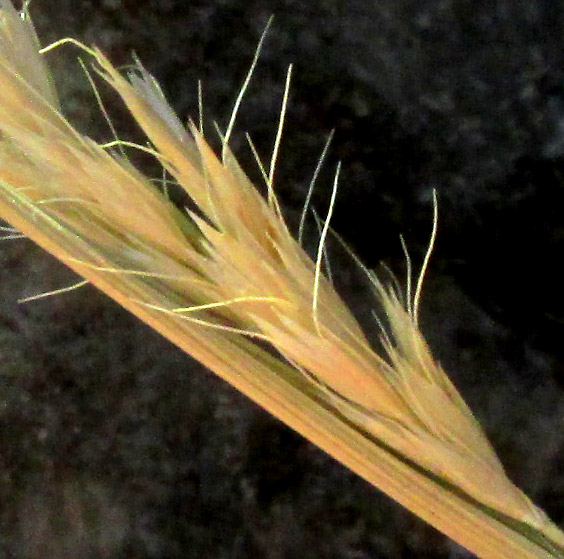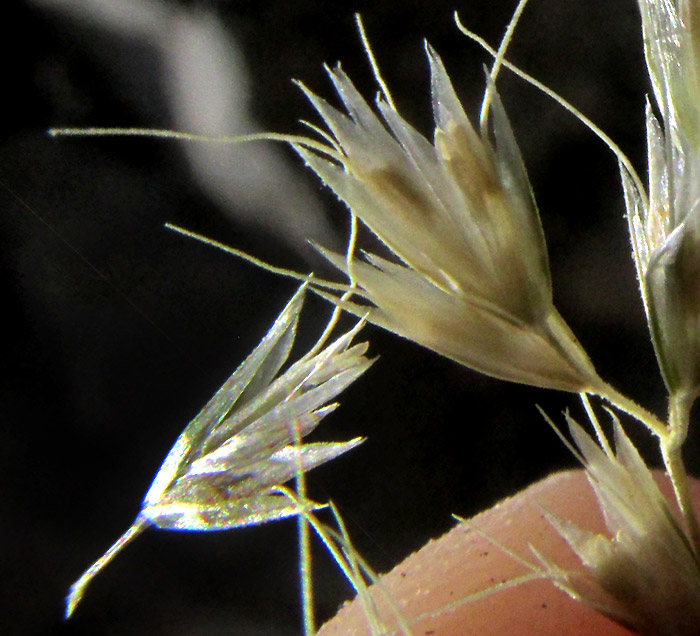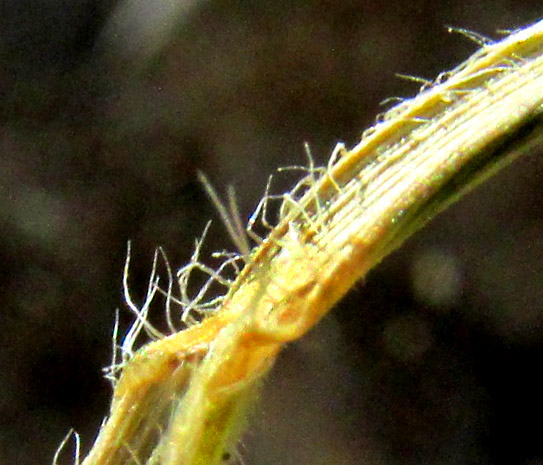Excerpts from Jim Conrad's
Naturalist Newsletter
Entry from field notes dated June 28, 2023, taken beside gravel road running beside the crest of the ridge rising on the southwestern side of Curva de la Doctorcilla, which is near km 18 on the branch road beginning at El Campamento and continuing to El Doctor, and which is numbered Hwy 120, though it branches off the main Hwy 120 running between San Juan del Río and Jalpan; limestone bedrock; elevation ~2930m (~9600 ft), Querétaro, MÉXICO, (N20.85971°, W99.60541°)
SPIKE TRISETUM

Beside the one-lane gravel road cut into the ridgetop, the above much branched, drought stressed grass rooted in thin, lichen-covered soil between the roadcut's exposed limestone rocks. The spot was exposed to intense sunlight, wind and temperature extremes, and currently a long, severe drought still was taking place, so one had to admire the plant's adaptive vigor.

Close-up, the spikelets showed themselves to be arranged in a panicle-type inflorescence which held its spikelets so close to the stem, or rachis, that the inflorescence looked spike-like. The florets' needle-like awns bent outward at their bases, giving the flowering head a bristly appearance.

To see individual spikelets more clearly, the inflorescence was disarranged and bent, resulting in the above view. One spikelet, at the above picture's lower left, had come loose, affording a look at a single spikelet. Important identification features include these field marks: the spikelet bears two florets; a brisle-like awn arises from the middle of each lemmas' back and not from the lemma tip or base; below the two florets, the spikelet's upper glume is as long as the florets but the lower glume is shorter, and; the spikelet bears a stemlike pedicel.

The grass's blades were slender, their margins somewhat in-turned, and they bore long hairs. Blade bases constricted a little before enlarging into a cylindrical sheath surrounding the stem. At the point of connection with the sheath, a ligule was formed. The above image poorly shows the ligule, but its white, membranous tip is barely visible at the blade's base.
In our upland central Mexican region, a grass with its spikelets arranged in narrow, spikelike panicles as seen above, with the spikelets borne on pedicels and bearing two florets with bent awns arising from the middle of their lemmas' backs, if you refer to the various available treatments of grass species, you're led to the genus Trisetum. Species of Trisetum often are referred to as oatgrasses, because the long glumes at the spikelets' bases suggest a close relationship with oat grass. In general, the 75 or so species of Trisetum are said to occur mainly in the world's temperate, subarctic and alpine habitats, which includes highlands in tropical countries, such as here.
In our central Mexican uplands region, consulting the available floras, it's seen that seven or so Trisetum species have been documented. Among those, if the awn is inserted at about the middle of the lemma's back and is no longer than 4mm long (1/8th inch), and the inflorescence is narrow and spikelike, you have Trisetum spicatum, usually known in English as Spike Trisetum, or Spike False Oat.
BUT... Recent genetic analysis has exploded the old genus Trisetum; the standard floras' Trisetum species now are scattered here and there among various genera. The impressive, insightful 2019 study by Patricia Barberá and others entitled "Molecular phylogenetic analysis resolves Trisetum (Poaceae: Pooideae: Koeleriinae) polyphyletic: Evidence for a new genus, Sibirotrisetum and resurrection of Acrospelion," reassigned our Trisetum spicatum to another genus. Now it's KOELERIA SPICATA.
Most works found online still use the name Trisetum spicatum, however, plus some authorities are slow to accept the evidence. Moreover, the common name of Spike Trisetum still prevails, though our plant no longer is a Trisetum. That's the way it goes.
Spike Trisetum is remarkably widespread in the world's cooler zones, mainly in Eurasia and the Americas, and it's very variable in appearance. In the 2005 study by Víctor Finot and others entitled "A Revision of Trisetum (Poaceae: Pooideae: Aveninae) in South America," it's stated that "Trisetum spicatum has been treated as a complex including a vast number of subspecies and/or varieties," most of which aren't now recognized as valid entities. They blend together.
The Flora of North America says that Spike Trisetum's stems range from 10-120cm (4-47 inches) long, so our grass is at the short extreme. Its extremely dry and exposed habitat probably accounts for most or all of that.
It's illuminating to study that earlier-mentioned Trisetum-redefining work by Patricia Barberá and others. If you have a basic sense of the major grass genera, it's worth downloading the phylogenetic tree accompanying the publication. The study can be downloaded for free from several ebsites; just do a search on the publication title.
For example, a species of the Oat genus Avena was used as the study's outgroup, the outgroup ideally being a "sister" species that emerged from an immediate common ancestor along with the group you're studying. In a sense, the outgroup establishes a "theme," and the various species you're working with are "variations on the theme." You can see the basic theme established for species in the study's phylogenetic tree by looking at our Oat grass page, paying special attention to spikelet structure -- the spikelet's long glumes, the awn arising from the back of the lemma, the slender pedicel, etc. Those features establish the oat-grass theme that is played out so prettily in the phylogenetic tree.